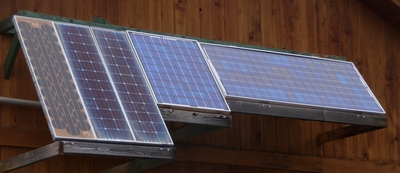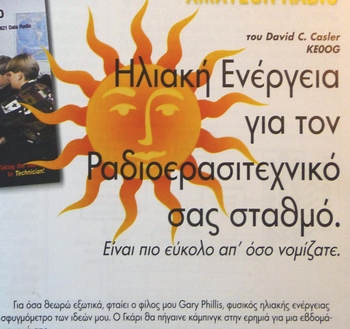
Photovoltaic solar panels at KEØOG power my ham station plus several lights in the house. I've been adding to the system over the years. My original panel is the Arco 33-watt unit at the very left.
So what do I use? Primarily solar power. The solar photovoltaic panels shown in the image above collect about 250 watts peak. These are connected to serious 12-volt absorbed glass mat (AGM) deep-cycle batteries designed specifically for solar-powered systems. These batteries were seriously expensive and last about a decade, perhaps more. I have a small 12 vdc to 120 vac inverter right at the batteries that powers several lights in the house. From the main batteries I run 20-gauge line to a “repeater” battery under my desk. That battery is a Walmart “marine” deep cycle battery, which will last about three years (I’m now on my third).
Why the repeater battery? Simple: My station is too far away from the main batteries. I’d have to run humongously-thick cables to power my rig. So, I power it from a nearby battery, which gives me lots of current during transmit, and when I’m not using it, it’s being recharged by the main solar system. Works like a charm! The only disadvantage is that my rig then sees the diurnal voltage cycle: down to 12.5 to 12.7 volts in the evening, and up to 14 volts during the day. This is rather hard on the repeater battery, so I simply buy an inexpensive ($58) marine deep cycle battery from Walmart, knowing I’ll have to replace it in about three years.

RigRunner 4012 power distribution strip that distributes the 12 vdc solar power in my station. Note the use of standard connectors.
I power my APRS station, consisting of an old DSP-232 TNC and an ICOM IC-2100 2-meter mobile rig, with a commercial power supply, in this case an MFJ-4225MV. Why not use the solar system? That’s because the APRS station is on the air 24×7 and the total power drawn could actually exceed the capabilities of my photovoltaic system during winter. I can use the PV system for my other rigs because they aren’t on the air all the time.
So how does it work? It works great! The solar recharge system ensures my batteries are always topped off. I did the math once and figured I could be on the air for more than three days straight (no sleep) and still not exceed the capacity of the system. It just works!

My 1999 QST article on Solar Power translated into Greek
If you’d like to learn more about how my station works, drag out the April, 1996, issue of QST and look at pages 33 through 37. That article, “Solar Power for Your Ham Station—It’s Easier than You Think,” was translated into Greek (yep, literally—see picture) for the Grecian equivalent of QST. The only part of that original PV system still in use is the Arco 33-watt panel at the very left in the picture at the top of the page.

I use a standard html trick of a slashed zero. Sometimes it isn’t displayed properly.
IS it just me, or is every1 seeing it this way…?
How come your callsign (from, eg, dCasler.com) appears (via browser Comodo IceDragon) on my Window 7 based laptop as “KEØOG”?
Dave,
Thanks for lesson on end fed antennas. Sounds like
It’s not for my QTH. Will focus on some kind of
Vertical.
73’s
K8GEN
Gary, antenna regulations and covenants are a complex subject. The satellite dishes are allowed by the FCC’s federal preemption some years ago. There is a bill pending before Congress to also allow ham radio antennas even though the covenants might forbid them. I personally don’t like end-fed antennas because of the RFI issues—the feedline radiates and there can be RFI in the station. There are a variety of multi-band verticals available. Some require radials and some do not. Look at the ARRL books on antennas: there are some books that may be of interest having to do with attic, stealth, or low visibility antennas. Good luck on getting on HF! 73, Dave
Have thought about a lesson on “end fed antennas”?
Thinking about that or a mono- band vertical. Live in a
Retirement housing development. Each resident is a
Duplex. No common area. Pretty nice size back yard.
Rules say”no antenas or tv antennas or tv satellite dishes.
But they are dishes everywhere!! Seems like some rules
Don’t apply??
Thanks
Gary,
K8GEN
Gary, these days I’d say look at one of the many commercially-produced verticals. You can also look up articles on the Internet and in the ARRL Handbook and Antenna Book. While I’ve made many dipoles from scratch, never verticals (except 2m). Good luck! 73, Dave
Dave,
12 gauge sounds more like it. I was thinking” 20 gauge is WAY too small”
Thanks for clearing that up.
I’m looking for a dual band vertical to build for our new QTH.
Thought I’d remembered one in and old handbook that used
A inductor between 2 aluminum poles to give 15/40??
Have any suggestions.
73’s
Gary, K8GEN
The repeater wire is 12 gauge.
Dave,
Did you really mean 20 gauge wire for repeater battery, or 2/0 wire?
73’s
Gary
K8GEN
Coy, if you are a member of ARRL, you can access QST online. Look for my article starting on page 33 of the April, 1996, issue. There are many sources online for solar panels. Also, the ARRL’s book, Emergency Power for Radio Communications (ISBN 978-0-87259-615-3) at this link, has lots more information. Chapter 3 is devoted to solar power. Table 3-1 lists several manufacturers. It’s been several years since I last purchased a panel, so I’m sure the market has changed since then. Hope that helps! 73, Dave, KEØOG
I happen to read your article. This sound greatly great. Where can I located the electric components to build the photovoltaic system? I’ m in Florida with a lot if sunshine and I want to turn that solar energy into power to run my Kenwood TS-820S transceiver system . Your assistance and guidance will be greatly appreciated.
73
Coy
KK4JMP